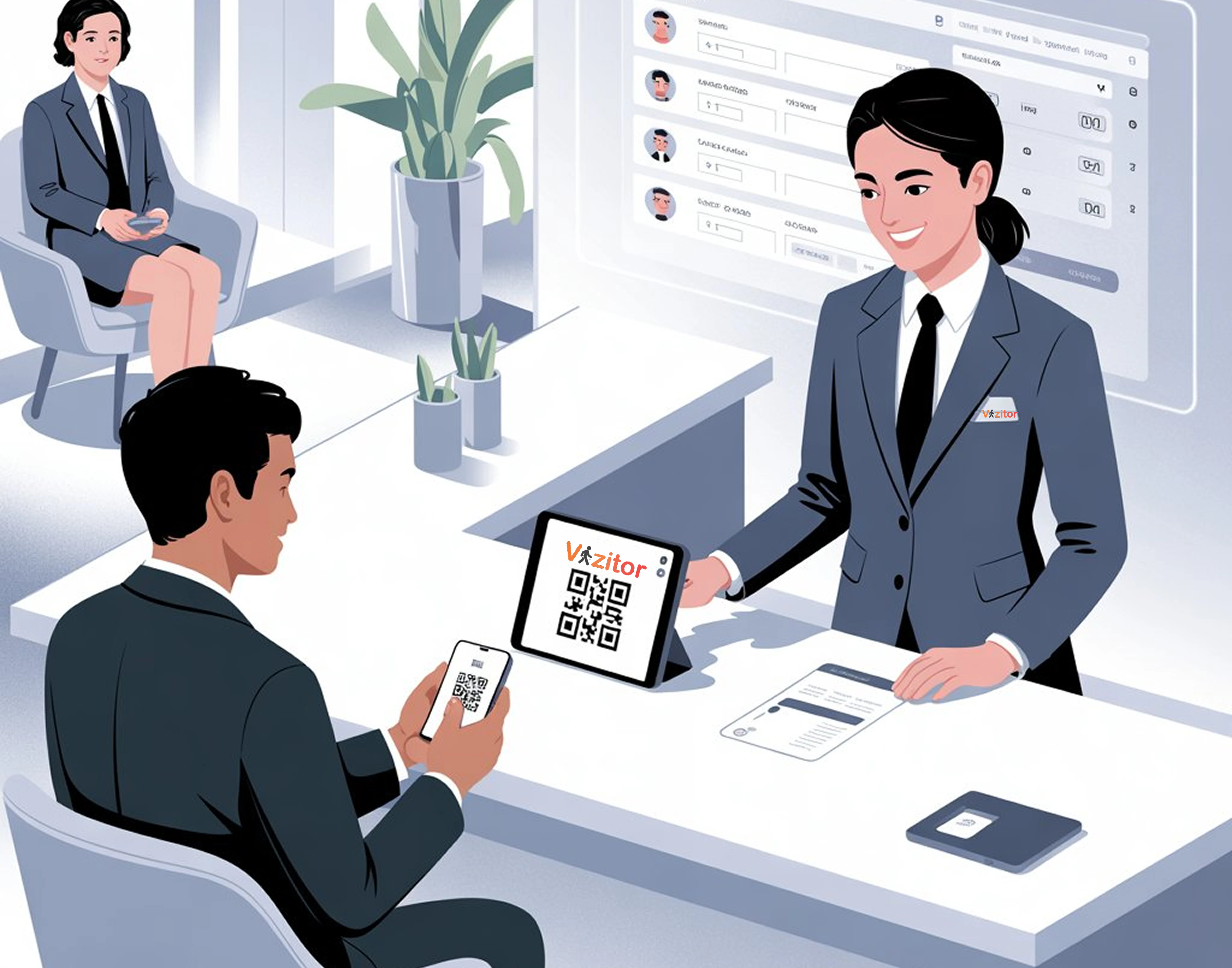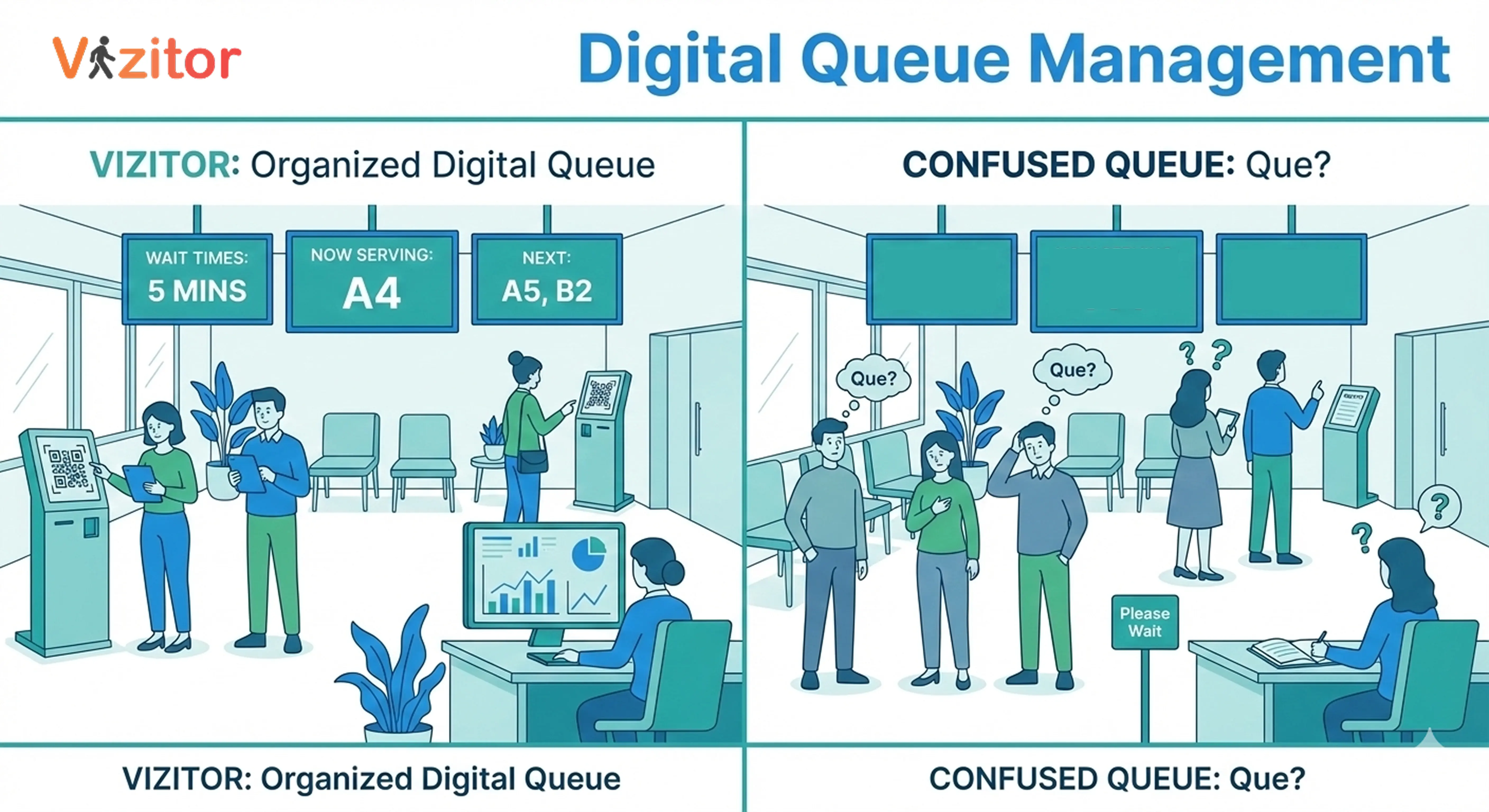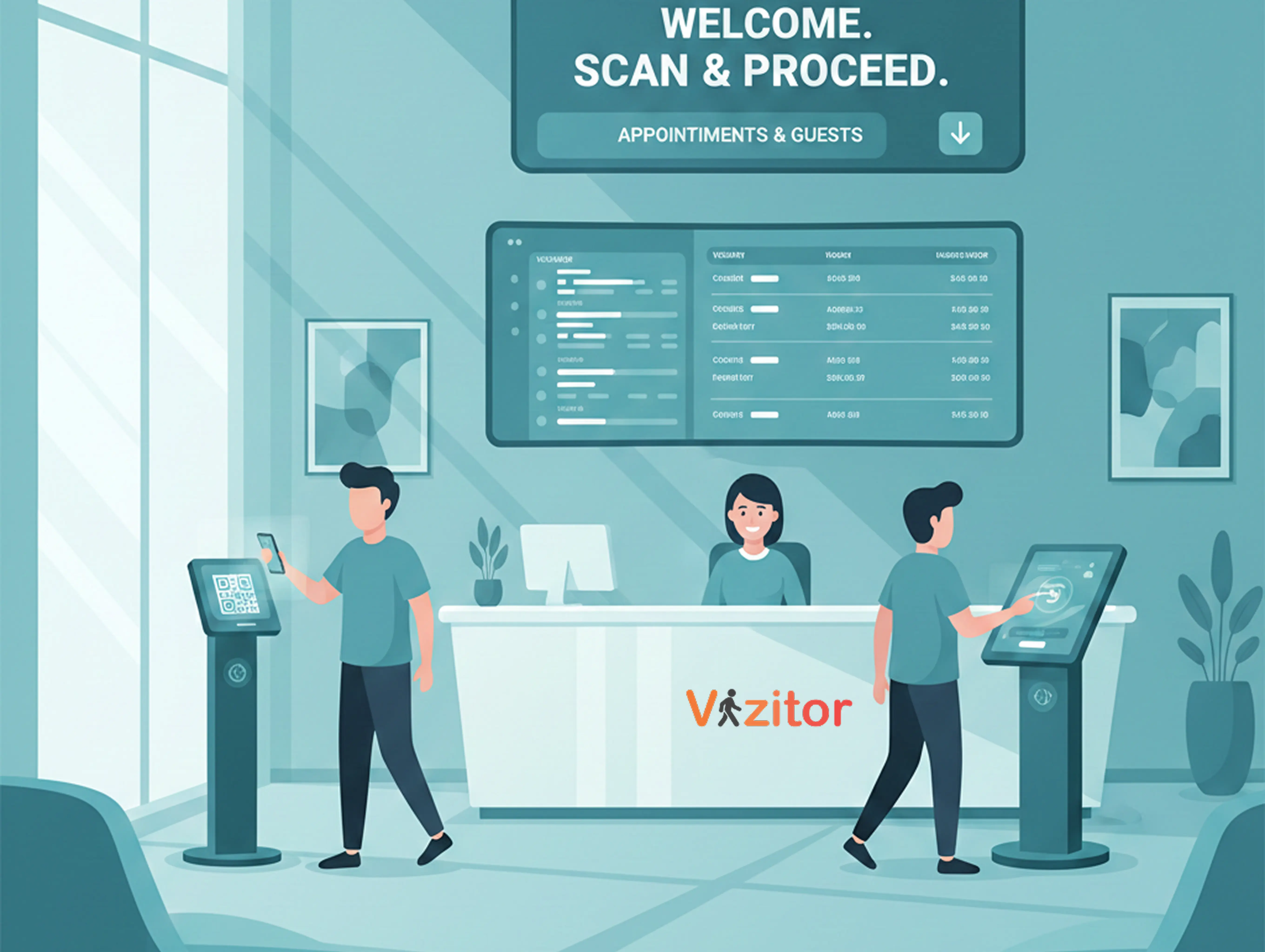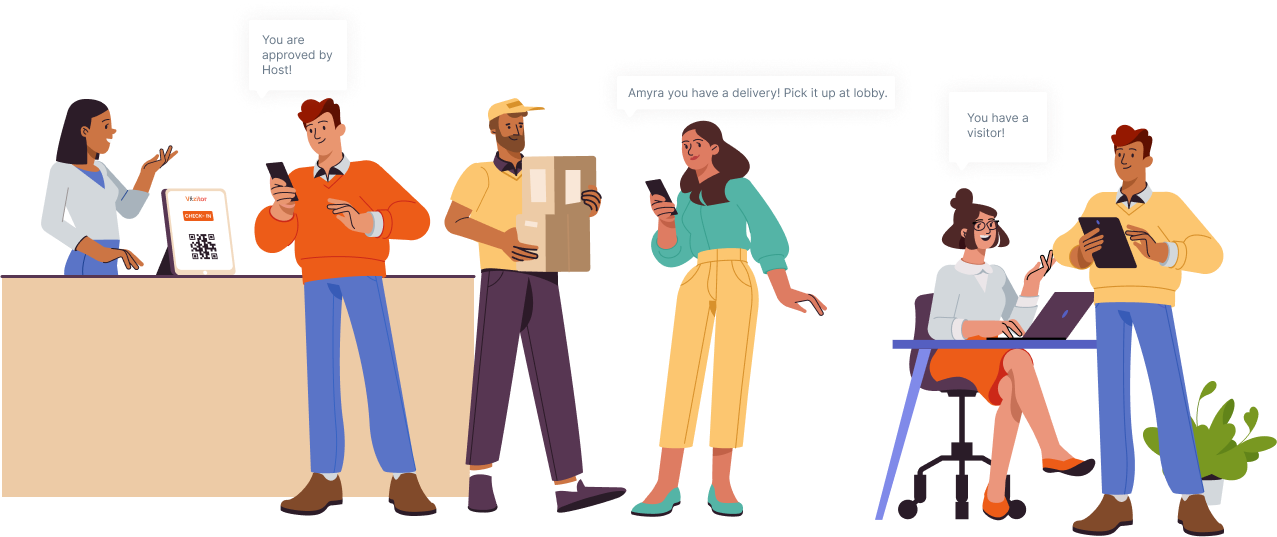How QR Code Visitor Management Systems Work
QR code visitor management systems replace outdated paper logbooks with fast, secure, and contactless check-ins. Visitors simply scan a QR code, get verified, and receive a digital or printed badge while their host is instantly notified. These systems improve workplace security, streamline visitor flow, and ensure accurate digital records. Scalable and easy to integrate, they are now essential for offices, schools, hospitals, and enterprises seeking a modern visitor experience.
Table of Content
Try Vizitor for Free!

Published on: Fri, Sep 19, 2025
Last updated: 2025-09-16
Read in 6 minutes
Introduction
In today’s digital-first workplaces, security and visitor experience go hand in hand. Traditional paper logbooks have become outdated, inefficient, and insecure. Enter the QR code visitor management system: a modern, contactless solution that makes check-ins faster, safer, and more reliable.
This blog explains exactly how QR code visitor management systems work, why they are transforming offices, hospitals, schools, and enterprises across the U.S., and how to choose the right one for your organization.
What Is a QR Code Visitor Management System?
A QR code visitor management system (VMS) is a digital solution that allows visitors to check in using their smartphones. Instead of writing details in a logbook, visitors simply scan a QR code displayed on a tablet, reception desk, or sent in advance via email/SMS.
- Visitor Data Capture: Contact details, purpose of visit, and host information are digitally recorded.
- Digital Pass Generation: A unique digital visitor badge or pass is created.
- Host Notifications: The system instantly alerts the host via email, SMS, or app notification.
- Access Control Integration: QR codes can be linked with smart gates or access cards.
This makes visitor management secure, touchless, and scalable.
Why Are QR Codes Used in Visitor Management?
QR codes are ideal for visitor management because:
- They are fast and contactless.
- Easy to generate and scan.
- Secure, each code can be unique and time-bound.
- Work with any smartphone camera, no special hardware needed.
- Reduce waiting time at busy receptions.
According to workplace tech surveys, 75% of U.S. businesses prefer QR-based systems for their convenience and ability to support compliance requirements like HIPAA, OSHA, and CCPA.
How Does a QR Code Visitor Management System Work? (Step-by-Step)
Here’s a breakdown of the workflow:
1. Pre-Registration
- Visitors receive a unique QR code via email or SMS before arriving.
- The code contains encrypted visitor details and appointment info.
2. Arrival & Check-In
- At reception, the visitor scans the QR code on a tablet, phone, or reception desk display.
- The system verifies the code instantly.
3. Identity Verification
- The visitor may be asked to show an ID document or upload a digital copy for compliance.
- Some systems integrate with facial recognition or government ID databases.
4. Host Notification
- The host receives an instant notification via SMS, email, or mobile app.
- This reduces delays and improves professionalism.
5. Visitor Badge Generation
- A digital or printed badge is issued, often including the visitor’s name, company, photo, and QR code for exit.
6. Access Control Integration
- QR codes can be synced with door locks, elevators, or meeting room access.
- Visitors only enter authorized areas.
7. Check-Out Process
- Visitors scan the same QR code when leaving.
- The system records the time-out automatically.
Key Features of a QR Code Visitor Management System
- Contactless Check-In: Visitors don’t touch shared surfaces.
- Digital Visitor Badges: Secure and easy-to-track credentials.
- Real-Time Analytics: Track who’s inside at any time.
- Compliance Support: Digital logs help meet legal requirements.
- Integration Options: Works with meeting room booking, attendance management, and access control.
- Custom Branding: Add logos and personalized workflows.
Benefits of QR Code Visitor Management Systems
1. Enhanced Security
Digital visitor records reduce risks of unauthorized access. QR codes are unique and time-bound.
2. Improved Compliance
U.S. companies can meet HIPAA, ITAR, OSHA, and CCPA compliance by storing accurate visitor records digitally.
3. Better Visitor Experience
Visitors enjoy quick, contactless entry without waiting in long queues.
4. Cost Savings
No need for large reception staff or expensive kiosks, tablets and smartphones are enough.
5. Scalability
Works for small offices, large corporate campuses, hospitals, or even government facilities.
6. Real-Time Insights
Know exactly who is inside your building at any time.
QR Code Visitor Management in Different Industries
- Corporate Offices: For managing high volumes of client and vendor visits.
- Healthcare (Hospitals & Clinics): For patient attendants, vendors, and contractors while ensuring HIPAA compliance.
- Educational Institutions: For guest lecturers, parents, and vendors.
- Manufacturing & Factories: For contractors and delivery personnel.
- Government & Defense: For strict access control and audit-ready visitor logs.
QR Code vs. Traditional Visitor Management
| Feature | QR Code System | Traditional Logbook |
|---|---|---|
| Speed | Instant check-in | Slow manual entry |
| Security | Encrypted & secure | Easily forged |
| Compliance | Digital records | No compliance tracking |
| Cost | Low maintenance | High admin workload |
| Analytics | Real-time | None |
How to Choose the Right QR Code Visitor Management System
- Ease of Use: Simple scanning and check-in for all users.
- Security Features: Encrypted QR codes, ID verification, host approvals.
- Integration: With access control, meeting rooms, and attendance systems.
- Scalability: Works for both single offices and large enterprises.
- Compliance Support: Must support HIPAA, GDPR, OSHA, and CCPA.
- Cost-Effectiveness: Subscription plans that match your budget.
Implementation Best Practices
- Train reception staff to assist first-time users.
- Place tablets or QR code displays at visible spots.
- Encourage pre-registration for smooth check-ins.
- Customize workflows for different visitor types (guests, contractors, vendors).
- Monitor analytics to improve efficiency.
Conclusion
A QR code visitor management system is more than just a check-in tool, it’s a complete solution for security, compliance, and visitor experience. Whether you run a small office or a large enterprise, adopting a QR-based system can save time, reduce risks, and modernize your workplace.
If you’re ready to transform your visitor experience, Vizitor offers an all-in-one solution with QR code check-ins, digital badges, compliance features, and integrations with attendance and meeting room management.
Ready to modernize your front desk?
Upgrade to a secure, contactless, and scalable visitor management solution with Vizitor.
Contact Us Today to book a free demo and see how QR code check-ins can transform your workplace.
FAQs
1. What is a QR code visitor pass?
A QR code visitor pass is a unique, time-bound code that allows secure, contactless check-in for each visit.
2. Can QR codes be reused by visitors?
No, QR codes are unique and time-limited, preventing unauthorized reuse.
3. Do visitors need to download an app?
Not always. Most QR code visitor management systems, including Vizitor, work with any smartphone camera without extra apps.
4. Is QR-based visitor management safe?
Yes, QR codes are encrypted, and systems often include ID verification and host approval for added security.
5. How much does a QR code visitor management system cost?
The cost of a QR code visitor management system depends on features, users, and scale. Basic plans typically start from $36 per month, making it affordable for small businesses, while enterprise-grade solutions with advanced integrations and compliance features are priced higher.
6. What features should I look for in a visitor management system?
Key features include contactless check-ins, digital visitor badges, real-time notifications, compliance tracking, access control integration, analytics dashboards, and scalability to match your business size.
7. What’s the ROI of implementing a visitor management system?
The ROI comes from saved reception time, enhanced security, reduced compliance risks, improved visitor experience, and digital analytics. Many businesses see cost savings and efficiency improvements within months.
8. Can a visitor management system handle employee attendance as well as visitor logs?
Yes, advanced systems like Vizitor combine visitor logs with employee attendance tracking, offering GPS check-ins for field staff, biometric integrations, and shift management features.









